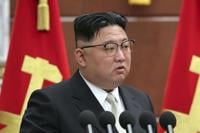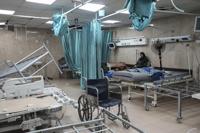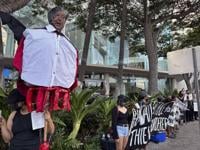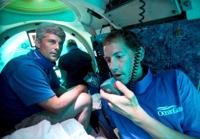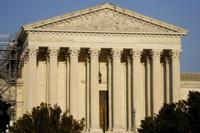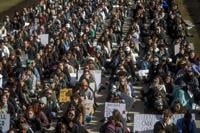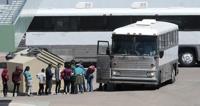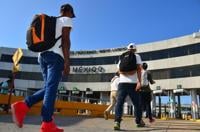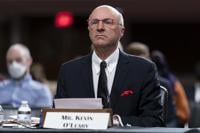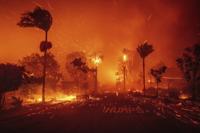SEOUL, South Korea (AP) — North Korea launched a short-range ballistic missile toward the sea on Sunday, its neighbors said, ramping up testing activities in response to ongoing U.S.-South Korean military drills that it views as an invasion rehearsal.
The North’s continuing missile tests showed its determination not to back down despite the U.S.-South Korea exercises, the biggest of their kind in years. But many experts say the missile tests are also part of North Korea's bigger objective to expand its weapons arsenal, win global recognition as a nuclear state and get international sanctions lifted.
The U.N. Security Council scheduled an emergency open meeting Monday morning at the request of the United States, United Kingdon, Albania, Ecuador, France and Malta in response to North Korea's previous ICBM launch March 16.
The missile launched Sunday from the North’s northwestern Tongchangri area flew across the country before landing in waters off its east coast, according to South Korean and Japanese assessments. They said the missile traveled about 800 kilometers (500 miles), a range suggesting the weapon could target South Korea.
The chief nuclear envoys from South Korea, Japan and the U.S. discussed the launch by phone and strongly condemned it as a provocation and threat to peace on the Korean Peninsula and in the region. They agreed to strengthen coordination and issue a firm international response, according to Seoul’s Foreign Ministry.
The launch was the North’s third round of weapons tests since the U.S. and South Korean militaries began joint military drills last Monday. The drills, which include computer simulations and field exercises, are to continue until Thursday.
South Korea’s military said it will continue joint drills with the U.S. and maintain a readiness to “overwhelmingly” respond to any provocation. As part of the drills, the U.S. on Sunday flew long-range B-1B bombers for joint training with South Korean warplanes, according to South Korea’s Defense Ministry.
North Korea is highly sensitive to the deployment of B-1Bs, which can carry a huge conventional weapons payload. It responded to the February flights of B-1Bs by test-launching missiles that demonstrated potential ranges to strike some air bases in South Korea.
Japanese Vice Defense Minister Toshiro Ino said the most recent missile landed outside Japan’s exclusive economic zone and there were no reports of damage to vessels or aircraft. He said the missile likely had an irregular trajectory, a possible reference to North Korea’s highly maneuverable, nuclear-capable KN-23 missile.
The U.S. Indo-Pacific Command said the latest launch doesn’t pose any immediate threat to the U.S. territory or its allies. But it said the North's recent launches highlight “the destabilizing impact of its unlawful” weapons programs and that the U.S. security commitment to South Korea and Japan remains “ironclad.”
include its longest-range Hwasong-17 intercontinental ballistic missile designed to strike the U.S. mainland. The North’s state media quoted leader Kim Jong Un as saying that launch was meant to “strike fear into the enemies.”
Thursday’s launch, the North’s first ICBM firing in a month, drew strong protests from Seoul, Tokyo and Washington. It came hours before South Korean President Yoon Suk Yeol flew to Tokyo for a summit with Japanese Prime Minister Fumio Kishida.
agreed to resume their defense dialogue and further strengthen security cooperation with the U.S. to counter North Korea and address other challenges.
Ties between Seoul and Tokyo suffered a major setback in recent years over issues stemming from Japan’s 1910-45 colonial rule of the Korean Peninsula.
But North Korea’s record run of missile tests last year — it launched more than 70 missiles in 2022 alone — pushed Seoul and Tokyo to seek stronger trilateral security partnerships involving Washington, which also wants to reinforce its alliances in Asia to better deal with China’s rise and North Korean nuclear threats.
North Korea has missiles that place Japan within striking distance. Last October, North Korea fired an intermediate-range missile over northern Japan, forcing communities there to issue evacuation alerts and halt trains.
After Sunday’s launch, Kishida ordered a prompt response, including working closely with South Korea and the U.S., according to Ino, the Japanese vice defense minister.
A day before the start of the drills, The North’s state media said the submarine-launched missile showed the country's resolve to respond with “overwhelming powerful” force to the intensifying military maneuvers by “the U.S. imperialists and the South Korean puppet forces.”
According to South Korean media reports, the U.S. and South Korea plan more training involving a U.S. aircraft carrier later this month after their current exercises end.
The U.N. Security Council held an informal meeting Friday where the U.S., its allies and human rights experts shone a spotlight on the dire rights situation and increasing repression in North Korea. China and Russia denounced the meeting as a politicized move likely to further escalate tensions on the Korean Peninsula.
North Korea's U.N. Mission issued a statement Sunday calling the meeting about “our non-existent `human rights issue'" unlawful. It denounced the United States for waging a pressure campaign against human rights in the country as “a flagrant violation” of its dignity and sovereignty and accused Washington of being “the world's worst human rights violator.”
The North's U.N. Mission said the U.S. held Friday's meeting “while staging the aggressive joint military exercise which poses a grave threat to our national security."
__
Associated Press writers Yuri Kageyama in Tokyo and Edith M. Lederer at the United Nations contributed to this report.


